Day 22
Amplify CKLA
It wasn’t part of the Amplify CKLA lesson plan, but after all the hard work my students put into their first personal narratives, we had to stop and celebrate this morning.
Students met in groups of 4 to share their food memories. After each author shared, they gave an appreciation tied to the writing skills we’ve been trying out lately:
- “I liked your topic sentence because…”
- “I liked when you used dialogue…”
- “I liked the sensory detail where…”
- “I liked your concluding sentence because…”
Then we came back together as a class to debrief, and so I could build them up even more. This curriculum demands a lot of my students, and they are working their butts off to rise to the occasion. I want to take every occasion to celebrate their amazing effort!
Amplify Science
In today’s Amplify Science lesson, students are preparing to write their first scientific argument. To get us started, I introduced the idea of claims and evidence. One way we practiced is by studying an image of a subway. Students worked in partners to find evidence of different forms of energy in the image: light, thermal, motion, and sound. They rocked it!
They did not rock the next practice activity, which was a partner discussion about two possible claims that might answer the question of why a town had a blackout. Partner A was supposed to share all their thinking about one of the claims, and Partner B was supposed to share back what they heard. I then asked Partner Bs to share out with the class. Rather than address the claim on the board, all the Partner As apparently just shared all their own ideas about what could have caused the blackout. They ignored the claim completely.
This was a new skill, so I’m not totally surprised, but I realized, I needed to provide a little more support than what the lesson was offering. We talked through the claim together as a whole class. The picture shows some of the evidence we were able to come up with. We didn’t get to talk about the second claim because we had to go to lunch, but I know better how I want to launch it tomorrow to be a more productive and focused discussion.
Math
After some fumbling on my part for a couple lessons as I realized my students were having a VERY difficult time with rounding multi-digit numbers, I feel like I found a good structure today to move us forward.
We started with a low-stakes partner quiz. I put up multiple choice questions on the board asking students to identify between which two ____s a number is located. Students worked in pairs to determine the answer, and then they showed their answers on mini white boards so I could see what the entire class was thinking.
For many questions, the class was in agreement, but occasionally there would be two popular answers, so I knew we needed to talk about those problems in more depth.
After we got through 8 or so problems, I gave the students a practice sheet where they had to name the two ____s a number is in between without the benefit of answer choices. They felt very confident with this skill for the first time!
Next, we went back into another low-stakes multiple choice partner quiz. This time we tackled the question, what is halfway between ___ and ___? Again, they worked in pairs to determine an answer and then shared their answers on mini white boards. At the end, they got another practice page, this time focused on that exact same question, what is halfway between ___ and ___? And again, they seemed much more confident answering these questions.
We ran out of time, but tomorrow, we’re going to bring it all together and use those two questions as the first two steps of a solid strategy for rounding multi-digit numbers.

Day 23
Up until now, I’ve been teaching my students cursive. Now that they’ve learned all of the lowercase letters (which we use waaaaaay more frequently than capital letters), I’m transitioning cursive practice (including learning the capital letters) to homework so that I can finally begin Humanities instruction.
Humanities
I launched our first Humanities unit this morning. We’re going to be learning about the indigenous people who first settled in what is now known as New York.
Today’s lesson started with a community circle where we answered the question, “What name do you like to be called?” Then we watched a video where we learned about the Haudenosaunee, and how that is the name they call themselves. We also learned that the name Iroquois was given to them by European explorers. Finally, my students reflected on the questions, “How would it feel to you to be called by a name that isn’t yours?” and “What do you think of the fact that some people still call the Haudenosaunee by the name Iroquois?”
Amplify CKLA
I tried so hard today to teach one Amplify CKLA all in one day, and I just couldn’t do it. I cut and modified the lesson, and I still ran long!
For example, in one activity students were supposed to (1) preview seven questions they were going to answer about an article called “Introduction to Polio”, (2) read the article independently, and then (3) independently answer the seven comprehension questions in writing. Then we were supposed to (4) collaboratively create a timeline of events from the article. All this was allotted 20-ish minutes.
Here’s what I actually did in that time (in hopes that I could fit it all in): (1) We previewed the questions together as a class. (2) I read the article out loud to everyone. (3) Then we answered the questions orally as a class. That’s all. I had to skip making the timeline altogether, and I still went over on time!
It’s so infuriating to keep failing at getting through a lesson in the suggested time. It’s one thing if the timing is off on occasion, but when it’s off day after day after day, I feel like the curriculum developer has not done their job well.
Amplify Science
My students did not understand how to draw on all the learning experiences we’ve had in science to come up with evidence to support a claim. I gave up trying to follow the lesson plan. Instead, we worked together to analyze one learning experience at a time:
- a book we read on systems,
- a reference book about energy,
- our experience building a simple electrical system, and
- our experience using a digital simulation.
It took a lot of guiding and prompting, but they were able to come up with a lot of different pieces of evidence that could be used to write a scientific argument. Unfortunately, I can’t drag this lesson on any more, so we’re moving on tomorrow without actually writing the argument.
When I was new to Amplify Science last year, I was letting lessons stretch over so many days because I didn’t know what could or could not be skipped. As a result, my first unit (which was supposed to take 22 instructional days) took me from early October to the end of January to teach. (Keep in mind I only get to teach science for about 40-45 minutes every other day, and the Amplify Science lessons are supposed to take 60 minutes.) I swore to move at a faster pace this year!
Math
Yesterday’s lesson went great! First we focused on answering the question, “What two ___s is this number between?” Then we focused on answering the question, “What is halfway between these two ___s?” My students got lots of practice and were doing great.
Today I tried to bring it home by having them use the answers to those two questions to FINALLY round a multi-digit number. We did a problem together, where they had to figure out the information for each step and show it on mini white boards. They were doing great! Then I let them loose to solve some similarly-scaffolded problems and…. they fell on their faces.
I’m going to put rounding on the back burner and move on to multi-digit addition tomorrow. It just is not a priority skill for me to keep beating my head over it right now. I did create an additional practice assignment for them to do after their addition practice tomorrow where they’ll focus on just answering the first two questions of rounding, “What is it between?” and “What is the halfway number?” Clearly that needs more practice before they can use the answers to those questions to round a number.
Day 24
Slow Reveal Graph
We launched our day with a slow reveal graph.
Me: What do you notice and wonder about this?

S1: It’s a bar graph.
Me: What makes you say that?
S1: Those look like bars, and then at the bottom would be names or something. The numbers on the side tell you how many, like that small one is 65 because it’s halfway between 60 and 70.
Me: What could it be a graph of?
S2: Some number of objects?
Me: Let me reveal a little more information about the graph. What are you thinking now?
S3: Those are dates! October 4, 5, 6, 7, 8, 9, 10, and 11.
Me: Ah, they’re not names, they’re dates. What could these numbers have to do with these dates?
S4: Maybe it’s a number of points that was earned on each of those days.
Me: Interesting.
S5: Or maybe it’s the number of movie tickets sold.
S6: Or the number of glasses of lemonade sold!
Me: Hmm, I wonder why there are no bars on October 6, 7, 8, or 9.
S7: Maybe they didn’t sell any tickets on those days. Maybe they were sold out.
Me: Ok, let’s see some more of this graph.
S8: It says number of sign outs.
S9: Oh! I get it! It’s the number of times we sign out when we leave the classroom.
Me: Yeah, this is a graph of the number of times all of you signed out of our classroom to go to the bathroom or get water. We still haven’t figured out why there are no bars on these days.
S10: Oh! We didn’t have school on those days.
We proceeded to talk about how signing out nearly 90 times a day is enough times for each student to leave *5* times during the school day. I won’t ever stop anyone from leaving, but I do try to encourage students to only leave the room up to 3 times throughout the day: once in the morning before specials, once between specials and lunch, and once after lunch and before we go home. Students are also welcome to go on the way to/from specials and lunch.
Me: I’m guessing a lot of you probably don’t even realize how many times you leave the room each day. Here’s what I’m going to do. I’m going to give each of you 3 popsicle sticks. Every time you sign out, drop it in the bucket by the door. You can still sign out as many times as you need to, but I want you to notice how quickly you’re going through your popsicle sticks.
When I looked at our sign out log at the end of today, we only had 48 sign outs! We nearly halved the number of sign outs, and students were even coming up at the end of the day to tell me how many popsicle sticks they had left.
Fingers crossed we can continue to keep the number of sign outs down. It was getting ridiculous!
Humanities
In Humanities today, we looked at maps of land forms and bodies of water in New York. There’s a lot going on geographically-speaking in our state!
Amplify CKLA
One of these days I just need to accept I may never get through an entire Amplify CKLA lesson in one day no matter how quickly I try to move us through it. Today was the second day of Lesson 7, and we still aren’t quite finished. We did start brainstorming our next personal narratives. They seem excited to dive into writing their next story!
Math
Before diving into multi-digit addition, I wanted to get us thinking about regrouping.
Me: I made a mistake in this number. Can you figure it out? (The picture below shows a later example. The first example had a 3 in the hundreds, 2 in the tens, and 10 in the ones.)
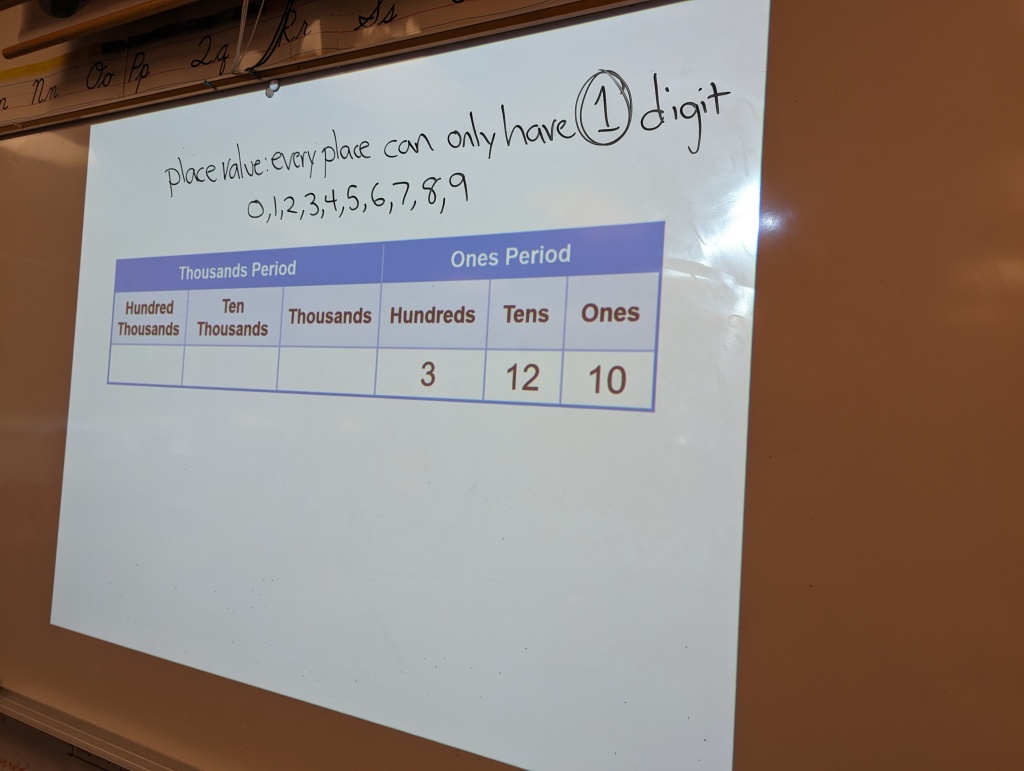
S1: You can’t have 10 in the ones place.
Me: What do you mean I can’t have 10 in the ones place?
S2: It can only be 9.
Me: Oh, so there has to be a 9 in the ones place.
S2: No, it can be 9 or less.
Me: Oh! It doesn’t have to be 9. It can be 9 or less. What do all those numbers 9 or less have in common?
S3: They’re one digit.
Me: Right, our place value system is designed so every place only has one digit in it. So can I do anything with this 10 to make this number fit the rules of the place value system?
S4: You can carry the 1 and leave the 0 in the ones.
Me: I don’t know what you mean by carrying the 1, but we can do something else with these 10 ones so there will be a 1 added to the number of tens.
S5: You can regroup?
Me: Yes! How many ones does it take to regroup them as 1 ten?
S5: 10 ones.
Me: Yes, 10 ones can be regrouped as 1 ten. So if I regroup all 10 of these ones, I’ll have 1 more ten, and how many ones will be left?
S6: 0.
Me: And how many tens will I have now?
S7: 13.
We also did a Which Would You Rather? routine at the start of our lesson today.
Me: Which of these two problems would you rather solve?
S1: I choose B because it has smaller digits like 2 and 4.
Me: What do you like about smaller digits?
S1: You don’t have to regroup.
Me: Oh, but over here in A you would?
S1: Yes, those digits are bigger like 9 and 6. If you add 6 and 8 you’ll have to regroup. It takes more thinking.
Me: What about the rest of you? What would you rather solve?
S2: I would rather solve A. Even though they’re only 2-digit numbers, you have to think more when you add them and I like more challenging problems.
When we finally got to adding, I let them try out the first problem (5,612+872) on their own since they all seem comfortable with the standard algorithm already.
When we came back together, we had three very similar answers:
6,384
6,484
6,684
Me: What do you notice about all of these possible sums?
S1: They all end in 4.
S2: They all start with 6.
Me: Those are all similarities. There are lots of similar digits. What jumps out to me is that even though so many digits are the same, there’s one place where they are different. Do you see it?
S3: In the hundreds place! There’s a 3, a 4, and 6.
Me: Can all 3 of these answers be correct for this problem?
S4: No, only one of them.
Me: That means at least 2 people made a mistake. Based on these answers, where do you think they might have made their mistake?
S5: When they were adding the hundreds!
Me: Yeah, since that one digit is different for all three sums, I’m guessing something happened there.
(We added the ones and tens and realized those were pretty simple since there was no regrouping, so then we looked at the hundreds.)

Me: What do you think went wrong here? (pointing to the hundreds column)
S6: You need to regroup when you add 6 and 8, so maybe they made a mistake when they were regrouping.
S7: I think they added 6 and 8 and got the wrong answer.
Me: Let’s see, how would you solve 6 + 8?
S8: I like to try and make 10, so I would take 2 from the 6. 8 + 2 is 10, so then I have 4 left, so it’s 14.
S9: I did it a different way. I started at 8 and then I just counted on 6 and got 14.
Me: So if the answer is 14 what digit should be in the hundreds place?
S10: 4.
Me: And if you look here in the thousands, all of these answers have a 6. Does it look like any of them made a mistake while regrouping?
S11: No, they all did that part right.
Me: This shows me that you all are comfortable with the steps of the algorithm, and you’re comfortable with regrouping. That didn’t cause you any problems at all. What did cause a problem was this little addition problem of 6 + 8. It’s so important that when you’re solving problems with numbers with lots of digits, you can’t let these little addition problems trip you up. We have to focus on being precise so our answer is correct.
Day 25
Humanities
Today we read an article from Newsela to learn more about the Haudenosaunee. As students read, they added noticings and wonderings to a t-chart, and then we shared out as a whole class.
Later, I showed students this image and asked them what they noticed and wondered.
S1: “I notice a lot of water around the land.”
Me: “How do you know it’s water?”
S1: “Because it’s blue.”
S2: “I wonder if this is a map that’s turned sideways. That white part at the top looks like Antarctica. It’s normally on the bottom.”
S3: “I think there might be a beach where that brown part is.”
S4: “I think I see the United States.”
Me: “Oh? Where do you see that?’
S4: (walks up and traces it with her fingers)
Other Ss: “Oh! I see it now!”
I traced the United States border with a marker and then asked if that could help them identify anything else on the map. They were able to identify Canada, Mexico, and Alaska.
Then I asked them if they could find New York on here. I had four volunteers share their guesses.
Before having students turn and talk to decide which guess they most agreed with, I asked, “Why do you think it’s challenging to find New York on this map?”
S5: “Because there aren’t any lines.”
Me: “Yeah, we’re used to seeing all the borders drawn on a map. If you look at the Earth from outer space, though, you’re not going to see those lines. They’re imaginary. We decide where they’re going to be on maps.”
I did this same activity last year and I loved it so much I had to repeat it again. The kids love trying to guess where New York is on a map of the Earth with no political boundaries drawn. They ultimately learned they can use the Great Lakes as a landmark to help them find New York.
Math
Today’s math lesson started with the Same and Different routine. I’m so glad that 25 days in, they are doing such a phenomenal job of looking closely and sharing their math thinking.
After the Same and Different routine, we studied a worked example showing two numbers added using the standard US algorithm. I tried a worked example earlier in the year, but I don’t think they were ready for it at the time. They were definitely ready for it today!
First, I asked students to analyze the work to see if it looked correct. Then they turned and talked with their partner about it. It was music to my ears to hear the room burst into conversation. Next, I put up the two questions shown on screen in the photo to get them to focus in on the regrouping: where it happens and why. After this they solved a different problem on their white boards before they went off to do independent practice.
All in all, we’re having waaaaay more success with addition than we were with rounding. I have been having my students continue to practice identifying what two ____s a number is between and what is the number halfway between those two ____s.
I also introduced them to the curved number line today in hopes that it makes it a little clearer how comparing to the halfway number helps us decide whether to round up or down. Here’s an example of a curved number line from an Origo video on YouTube. Click here if you’re interested in watching the video. It’s just over a minute long.









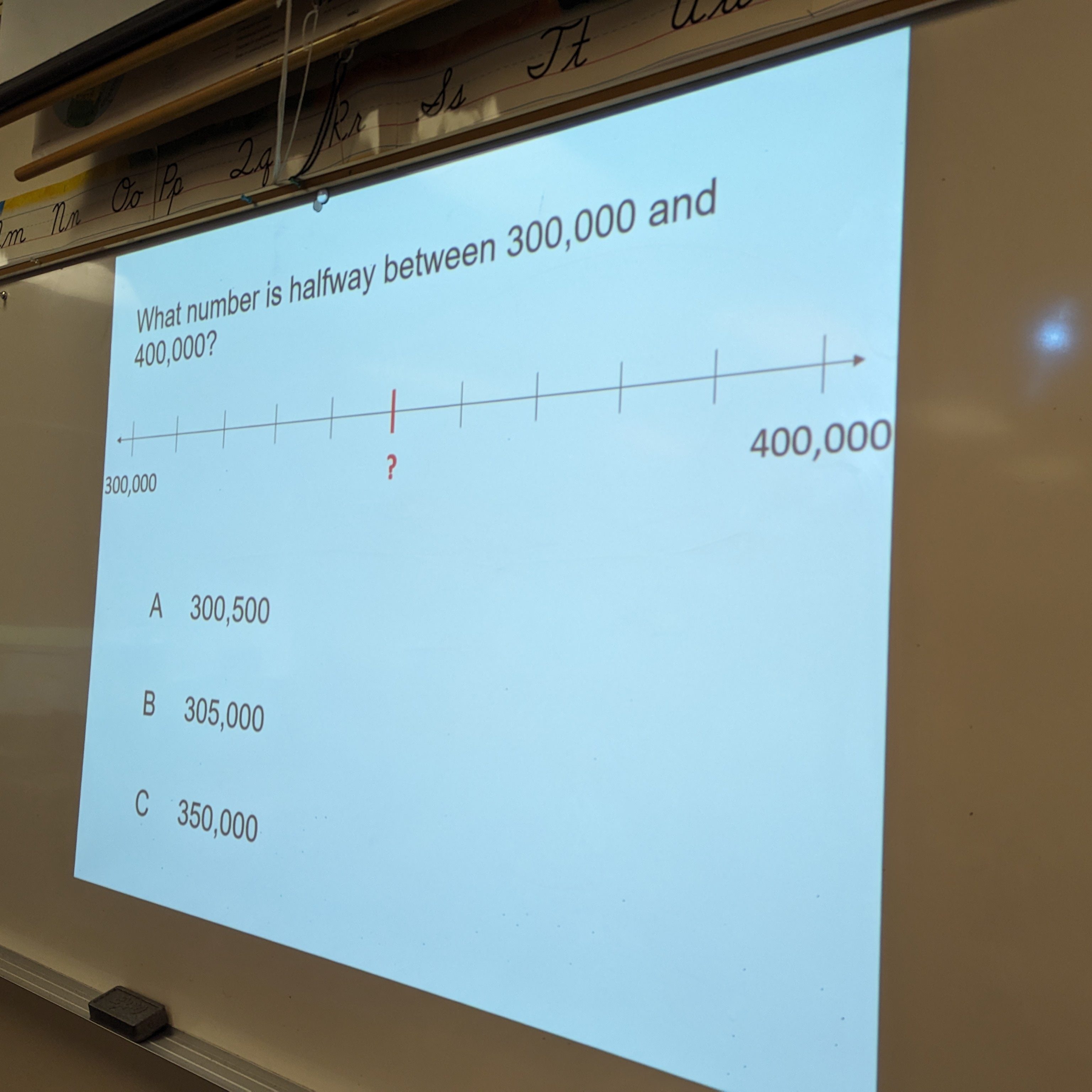


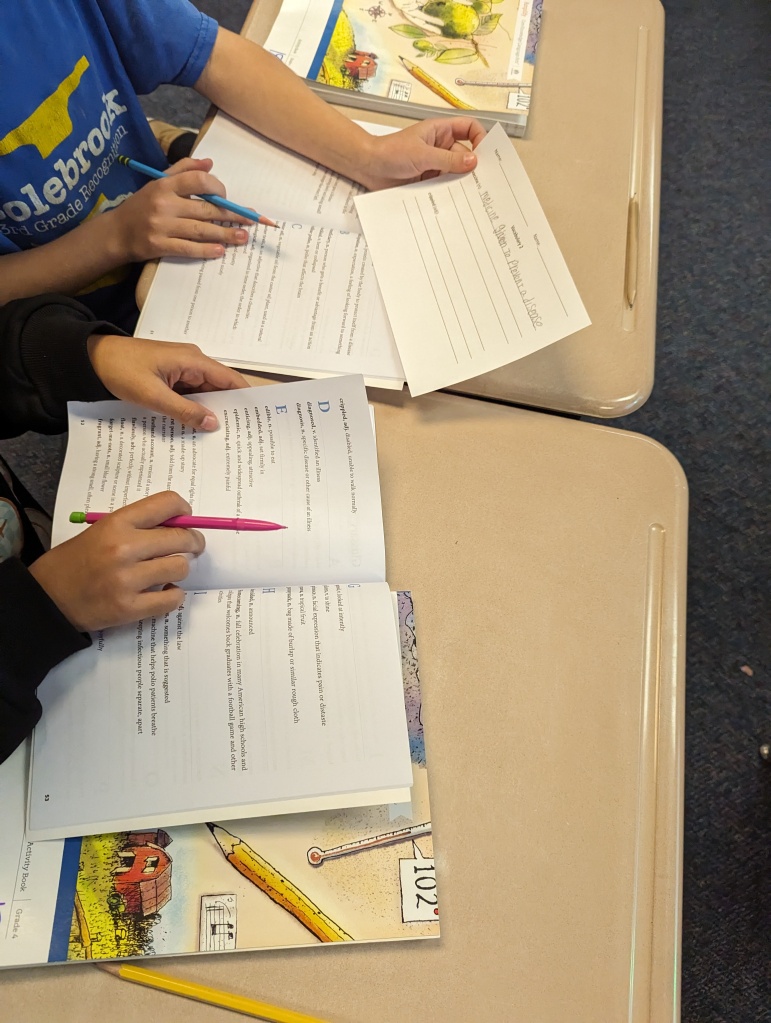








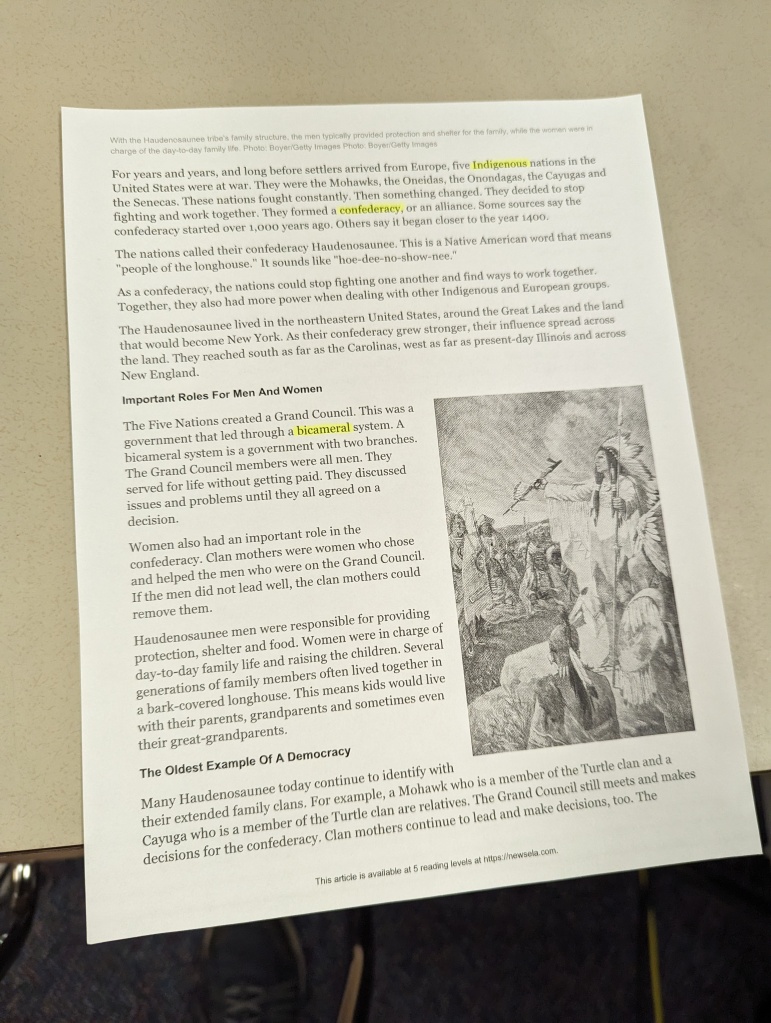


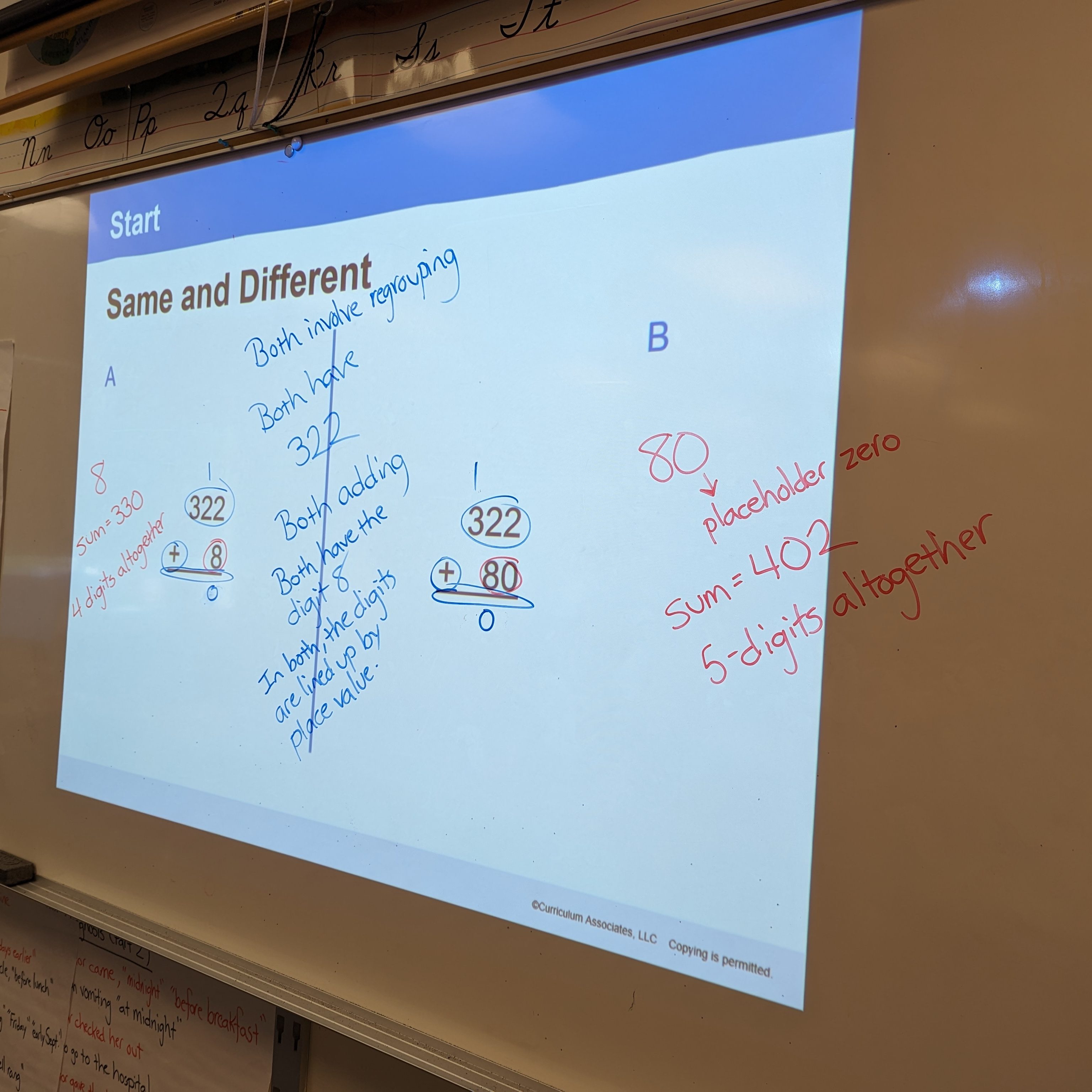


Love the Curvy Numberline! I’d never seen that before and it makes so much sense. Such a great visual. I also sometimes forget how much work Elementary school teachers do – it’s much easier to just teach one subject 🙂 Keep up the amazing work you’re doing – you’re students are so lucky to have you as their teacher.
I had been hesitant to use the curved number line at first because I didn’t want to confuse students since they were already having to think so hard about what a number is in between and what the halfway number is. I actually thought that knowing the halfway number would make rounding pretty easy, but it turned out not to be the case. Ever since I introduced the curved number line, I quickly realized how much it was helping many of them decide whether to round down or up.
Yeah, it is definitely a lot to manage when you have to plan for multiple subjects, but I love having one class of students all day because I love getting to talk to them about so many different things. It’s all trade offs!
Thank you for taking the time to read and share your thoughts.
🙂